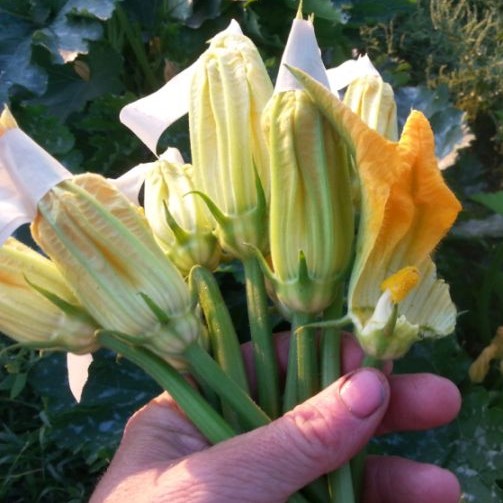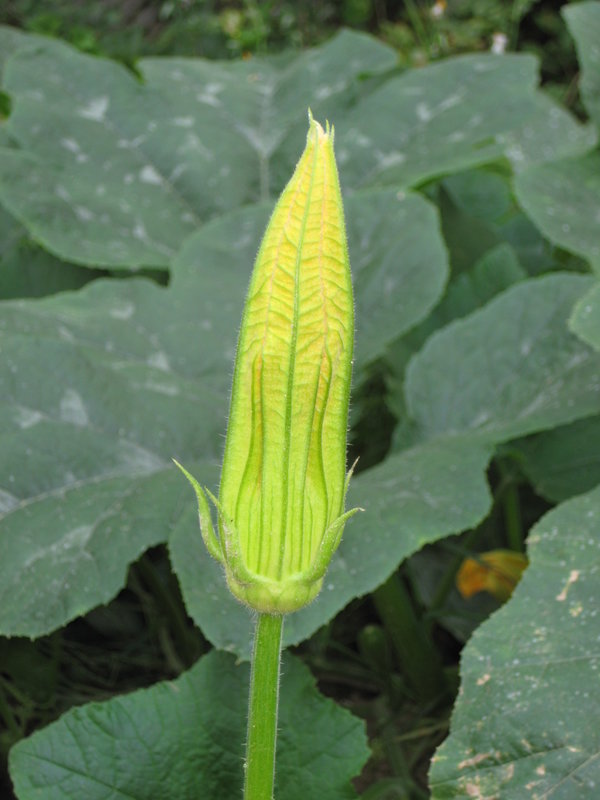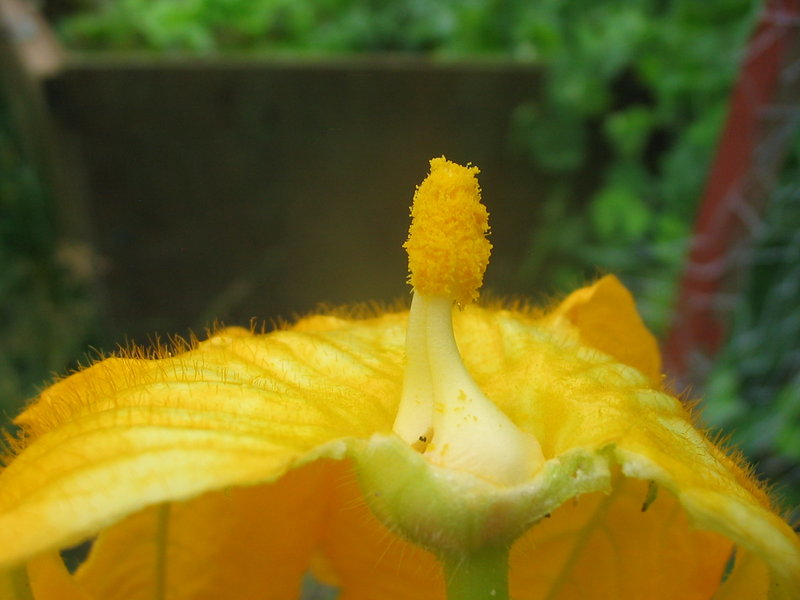Hand Pollination for Squash

This article is part of Seeds of Diversity's Squash Hand Pollination program. We have encouraged several of our members to grow squash this year and practice hand-pollinating them to save high-quality seeds. You can follow these instructions for any squash that you're growing this year, even if you haven't joined the program.
Squash love bees, and bees love squash
We often say that squash cross-pollinate with each other, but it's actually more correct to say that bees cross-pollinate them. Squash flowers cannot pollinate themselves like bean and tomato flowers can, because they grow in separate "male" and "female" forms. The male flowers make pollen, but can't make fruit. The female flowers make fruit, but can't make pollen. That's why squash need the bees: something has to carry pollen from one flower to another.
When bees visit squash flowers they're looking for pollen to eat and nectar to drink. But as they feed, pollen sticks all over their fuzzy bodies and falls off randomly during their visits so pollen from one flower can wind up in several others. That means every squash flower can be crossed with pollen from any other flower within a bee's flight range. Depending on the bee, that can be 250 to even 750 meters!
If you have a favourite squash, and you want to save its seeds, you'll have to stop bees from bringing pollen from other squash that far away. If you don't, then some of your seeds will be true-to-type, because they were pollinated by local pollen from the same variety, but some of your seeds will grow hybrids of your squash and another variety that you might not even know is out there. Maybe worse, you can't grow more than one variety of squash yourself and save the seeds. (or can you?)
(Yes you can)
There are a few ways that you can get around the intimidating isolation distance of squash. First of all, there are more than one species of plant that we call "squash" and they don't cross with one another. For example, pumpkins will cross with zucchini because they're both the same species (Cucurbita pepo) but neither of them will cross with butternut because that's a whole different species (Cucurbita moschata). They're actually different plants but we call them all squash, sort of the way we call chickens and turkeys "poultry" - some poultry can breed with each other, but some can't... To get an idea of which squash are which, https://en.wikipedia.org/wiki/List_of_gourds_and_squashes has an (incomplete) list of squash varieties classified by species.
So even if you can't isolate your favourite squash from other varieties, maybe you can isolate it from others of the same squash species. It makes the problem a little easier sometimes.
Hand pollination
The ultimate solution to squash isolation is to pollinate the flowers by hand. This is not as difficult as it sounds. Squash flowers are large, easy to handle, and pretty reliable under hand pollination. You can use the following instructions for any member of the same family (cucumbers, melons, watermelons, gourds) but since their flowers are smaller and more delicate, the operation is more difficult and there is a greater chance of damaging the flowers instead of pollinating them.
Check out this video to see how it's done. https://www.youtube.com/watch?v=eyNugsz7mE4
What you'll need:
- masking tape, painter's tape, or spring-powered clothespins
- ribbon or coloured yarn
- an evening and morning without rain
- a little patience
1. The first step is to find several male and female flowers that are ready to open, but haven't yet. Choose a summer evening when the weather forecast has no rain overnight or the next morning. Squash flowers tend to open in the early morning, so the previous evening they will be large, pale yellow, pointed, and most importantly, still closed.
- You can tell the difference between the males and the females by looking at the stems. Just beneath the flowers, the females have tiny baby versions of the squash that they will grow. On zucchinis you'll see a tiny zucchini at the base of the flower, on pumpkins you'll see a tiny pumpkin. On the male flower stems you'll just see the stem.
- It is highly recommended to pollinate each plant with pollen from other plants, of the same variety. Try to find at least a few males and females on each plant, so you can diversify the pollen throughout the population.

Flowers with sharp points have not opened yet. When they turn pale yellow it means they will open the next morning. This is a male flower (no tiny fruit at the base).

Flowers with floppy petals have already opened and been pollinated, so don't use them for hand pollination. This is a female flower (see the tiny fruit at the base).
2. Put masking tape or spring-powered clothes-pins on the pointed tips of the flowers (male and female) to hold them closed. Take care to fasten the top halves of the flowers, not the bottoms where the important parts are.
3. Early the next morning, have a look at your flowers. They will be swollen, trying to open, but hopefully still held closed. Meanwhile, the other flowers that you didn't fasten will be wide open and bees will already be feeding on them.
4. The objective is to gather the male flowers that you've fastened shut, and use their pollen to fertilize the female flowers that are also still held shut. As long as no bees have gotten into any of those flowers, all the pollination is under your control.
5. We usually pick the male flowers to do this. Sorry gentlemen, they have only one role to play and then they have no further use. With a brotherhood of male flowers in your hand, peel away the tape, and also the petals, until you find the bright yellow stamen inside each flower. Each should be covered with yellow, powdery pollen.

If bees have already gotten into the flower they will have eaten a lot of the pollen. This male flower has plenty of fresh pollen.
6. Find each female flower that you taped or clothespinned the evening before. Leave these on the vine, of course, and gently remove the tape or clothespin, taking care not to tear the petals. The stigma of this flower looks different, at least one reason being that it has no pollen. We leave the details to your imagination, but nature wants us to apply a mixture of pollen from several male flowers to the stigma of each female flower. As you complete the hand pollination, wonder to yourself whether you could demonstrate this to a crowd of gardeners without blushing.
7. To prevent bees from counteracting all your work, tape or clothespin the female flower shut again. It will take some time for the pollination to happen, and after that the flower will simply fall off of the newly-pollinated fruit.
8. Before moving on to the next pollination, be sure to mark your hand-pollinated flower with ribbon or weather-proof yarn tied somewhat loosely around the flower stem. Give it enough slack for the stem to enlarge, but not enough for it to fall off. A few months from now, this is the only way you'll be able to remember which squash were hand-pollinated.
9. During the next few days, watch the baby squash fruit on your hand-pollinated flowers. If the pollinations were successful, you'll see them grow larger quite soon. If not, you'll see the tiny squash wither and fall off along with the flowers. Sometimes heat is responsible for failure, or perhaps beetles eating the flowers from the insides. Just try it again.
Some tips and tricks
This is the exact method that's used to create hybrid squashes: an intentional cross of two varieties. Did you ever wonder what would happen if you crossed a zucchini and an acorn squash? Could you cross a white Lumina pumpkin and a yellow crookneck to get a weird halloween decoration? Sure, this is exactly how they do that. The only tricky part is that if you find a really cool combination, the seeds from that hybrid won't give you the same squash the following year. You'll have to repeat the same cross to get the same hybrid again, or go through a rather long process of stabilizing your new variety.
If you want to try this method with small-flowered relatives like cucumbers, the main cause of failure is damage to the flowers or not getting the pollen to the right place. A good solution is to tape the flowers closed until they're ready to open and then use a fine camel-hair artist's paintbrush to collect and transfer the pollen. You can see the yellow powder on the brush, so you know it's working, and if you're very gentle you can transfer the pollen without damage to the flowers.
If you ever grow squash or its family members in a greenhouse or sunroom where there aren't bees, hand pollination is simply the only way to get any yield at all.
Finally, sometimes your squash plants will have plenty of male flowers but no females. This is normal in early and late summer - before and after the prime time for pollination. If it's still early summer and your squash flowers have only just appeared, you'll probably find nothing but boys for the first few weeks. Just be patient. The girls tend to grow a little further from the center of the plant. On the other hand, if it's the later end of the season and the nights are getting chilly, you will probably also find nothing but boys. The squash plants know that any new fruit won't have time to ripen, so they conserve their energy and just focus on ripening the existing squashes.
Not yet a member?
An annual membership to Seeds of Diversity gives you access to our seed exchange, seed grow-out programs, and our online news.

We depend on donations to do our work.

Thank you for your support!
